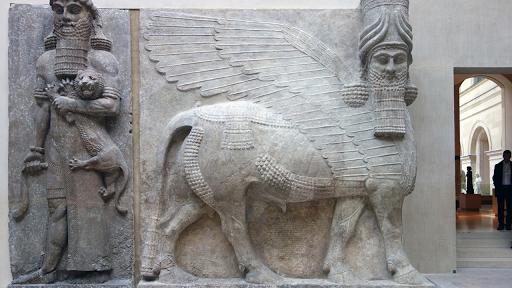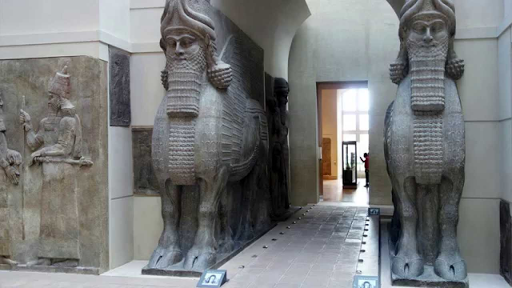What were the most common themes in Assyrian art. You can see them at Gate of All Nations at Persepolis in Iran the British Museum in London the Louvre in Paris the National Museum of Iraq in Baghdad the Metropolitan Museum of Art in New York and the University of Chicago Oriental Institute.

25 Lamassu From The Citadel Of Sargon Ii Dur Sharrukin Modern Iraq Ap Art History
Originally unearthed in Rome and displayed in the Borghese Gallery it was sold to the occupying French and now sits in the Louvre.

. Assyrian sculpture typically placed prominent pairs of lamassu at entrances in palaces facing the street and also internal courtyards. From Nimrud to Bloomsbury. What color is lapis lazuli.
Furthermore where were the lamassu sculptures originally displayed. Human-headed winged lion lamassu ca. Click to see full answer.
721-705 BCE Part of a collection at the Louvre in Paris France. It was considered by the Assyrians as a protective guardian of their houses palaces gateways and cities. 883859 BC undertook a vast building program at Nimrud ancient Kalhu.
The left lamassu seen above behind the ISIS narrator was uncovered again sometime before 1892 and a local man paid an Ottoman official for the top half of it cut it off and broken down over a fire in order to extract lime. Where were the lamassu sculptures originally displayed. The great Assyrian king Ashurnasirpal II r.
The lamassu in museums today including the Louvre shown in our video as well the British Museum The Metropolitan Museum of Art and National Museum of Iraq in Baghdad and others came from various ancient Assyrian sites located in modern-day Iraq. The Assyrians envisioned a protective spirit that was part bull and part human and sometimes part eagle. What ethnic group is credited with the first system of writing known to man.
The Lamassu sculptures were recovered from where. What ethnic group is credited with the first system of writing known to man. Lamassu was a characteristic of this late phase in the development of Assyrian art when sculpture was otherwise rare.
First of all the figure has five legs. The Ziggurat at Ur was a fortress funerary monument palace temple platform Where were the Lamassu sculptures originally displayed. The gate and its lamassu were first excavated by Sir Austen Henry Layard in 1849 but then re-buried.
The lamassu are human-headed winged lions or bulls therere many pairs of these sculptures that are still in existence including those in the British MuseumLondon LouvreParis and Metropolitan Museum of ArtNew York as well as several in Iraq. A Sargons palace b Gudeas Lagash c Ashurbanipals palace d Ziggurat at Ur Which of the following played an important role in the shaping of modern art. Mentioned in the Sumerian epic of Gilgamesh they were often incorporated into monumental entrance architecture and the two lamassu now in the British Museum originally flanked the doorway to the throne room of Ashurnasirpal II king of.
This was possibly the first time when Europeans watched the mythical monsters. Lamassu the were. On view at The Met Fifth Avenue in Gallery 401.
There are several fun facts about this sculpture. Where were the Lamassu sculptures originally displayed. The first change was the capital was moved to Dur Sharrukin present day Khorsabad and second the Lamassu was presented on a bulls body compared to a lions and seems to be slightly smiling.
The Lamassu sculptures were recovered from where. Lamassu are Assyrian protective deities whose hybrid bodies are part human part bull or lion and part bird. An American professor named Michael Rakowitz was commissioned to recreate this Lamassu sculpture and it is now displayed in Trafalgar Square in London.
They were represented as double-aspect figures on corners in high relief. Hermaphroditus was actually a popular subject of paintings and statuary even if Written By whitehouse March 11 2022 Add Comment Edit. Strengthening these bonds further were the so-called Panhellenic sanctuaries and festivals that embraced all Greeks and encouraged interaction competition and exchange for example the Olympics which were held at the Panhellenic.
Which work has a king approaching the god. Lamassu were powerfully evocative of strength speed and intelligence. The Lamassu seen from the side from the palace Sargon II r.
The most famous colossal statues of Lamassu have been excavated at the sites of the Assyrian capitals established by King Assurnasirpal II reigned 883 859 BCE and King Sargon II reigned 721 705 BCE. From what we can tell it seems that these sculptures were believed to protect the palace and king from evil supernatural forces as well. In some cases the lamassu statues were accompanied by.
From the ninth to the seventh century BC the kings of Assyria ruled over a vast empire centered in northern Iraq. These massive sculptures served as symbolic guards of Assyrian kings domain being placed at the entrance to both the city and palace gateways See Collins 2008 72. In the Assyrian mythology there were human headed winged bullslions that were protective genies.
This replica was made with 10000 Iraqi date syrup cans and serves as a symbol of. Which work has a king approaching the god Shamash. Currently representations of Lamassu are parts of collections at the British Museum in London Metropolitan Museum of Art in New York and The Oriental Institute in Chicago.

Lamassu Backstory Article Assyrian Khan Academy
Colossal Lamassu Sculpture From The Palace Of Sargon Ii At Khorsabad Sargon Ii Google Arts Culture

Lamassu Backstory Article Assyrian Khan Academy

Lamassu Symbol For Protection Indrosphere

Lamassus At The Louvre Thatmuse

Lamassu From The Citadel Of Sargon Ii Video Khan Academy
Human Headed Winged Lion Lamassu Assyrian Neo Assyrian The Metropolitan Museum Of Art
Human Headed Winged Bull Lamassu Assyrian Neo Assyrian The Metropolitan Museum Of Art
0 comments
Post a Comment